 |
|
Here and There introduces art, artists, galleries and museums around Japan that non-Japanese readers and first-time visitors may find of particular interest. The writer claims no art expertise, just a subjective viewpoint acquired over many years' residence in Japan.
|
|
 |
|
|
 |
 |
Hiroshima/Yokosuka: Miyako Ishiuchi at the Meguro Museum of Art
Alan Gleason |
|
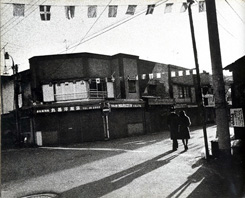 |
|
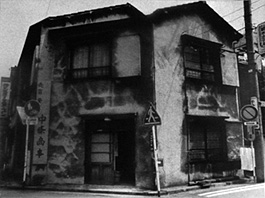 |
Miyako Ishiuchi,
"Yokosuka Story #30 (Honcho),"
1976-77
© Miyako Ishiuchi
|
|
Miyako Ishiuchi,
"Apartment #45 (Kamata, Tokyo),"
1977-78
© Miyako Ishiuchi |
One of the long-term fringe benefits of Japan's economic bubble of the 1980s is the cultural infrastructure bought with the municipal largesse of that heady decade. Tokyo's central wards and outlying cities went on a building binge that produced, among other things, some very handsome art museums. Meguro Ward, in the southern part of the city, has a particularly nice one which opened in 1987 in a corner of the Meguro Citizens' Center complex, a park-like setting alongside the Meguro River.
|
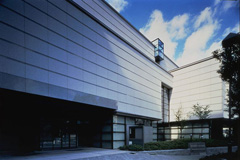 |
|
Outside view of the Meguro Museum of Art, Tokyo |
|
|
In a megalopolis whose cup runneth over with museums and galleries, curators often seem hard put to establish a distinguishing identity for their institutions. The Meguro Museum of Art declares a commitment to modern and contemporary Japanese art in general, but, befitting its role as part of a community center, naturally seeks out local luminaries. Hence it is not surprising that a recent exhibition there featured the photography of Miyako Ishiuchi, who lives in Meguro.
Ishiuchi, however, is not just any "local" artist, but an internationally acclaimed photographer whose gut-wrenching images distill the essence of human pain. Very much a child of the postwar era, Ishiuchi (born in 1947) was active in the student movements of the sixties. Her work, which first began attracting notoriety in the seventies, has always had a sociopolitical component.
Titled "Hiroshima/Yokosuka," the Meguro retrospective, which spans Ishiuchi's entire career, amply highlights this aspect of her work. Its centerpiece, a new set of works that may be the most understated yet disturbing of all, is a series of large color prints of articles of clothing, brightly backlit. What makes these clothes special is that they were all found on the bodies of people killed in the atomic bombing of Hiroshima.
Ishiuchi spent the better part of 2007 photographing these items at the Hiroshima Peace Memorial Museum, which has in its collection some 19,000 personal effects that survived the bombing, though their owners did not. She focused on dresses, shirts and other articles worn by the victims. Some are singed and in tatters, others astonishingly intact. Their owners ranged from the elderly to little children.
The Hiroshima series (also the subject of Ishiuchi's latest book) is a natural extension of themes that the photographer has been addressing for many years, as the sequence of the Meguro show makes plain. Ishiuchi made her first splash in 1977 with an exhibit of street scenes in her hometown of Yokosuka, a rough-and-tumble port best known for the huge U.S. Navy base that still dominates it today. She followed up with "Apartment," an acclaimed series of exterior and interior shots of decaying postwar apartment houses like the one she grew up in. Her large, coarse-grained black and white prints were typical of the are-bure (rough and blurry) style of street photography popular in sixties and seventies Japan.
Later, still working in black and white, she began to focus on the ravages that time and illness take on the human body with such series as "Innocence" (nudes of women scarred by surgery) and "Nails" (close-ups of the fingernails and toenails of working women and men). Her most recent work, exemplified by the huge prints of "Hiroshima," is in color and has a polished professional sheen that contrasts unnervingly with its subject matter.
Even as her style has evolved, Ishiuchi's images continue to grant no quarter to viewer sensibilities. The experience of moving from gallery to gallery, encountering one photo sequence after another that bears witness to pain and death with such unblinking intensity, is not for the faint of heart. It is to the credit of municipal museums like the Meguro that they have the vision and commitment to display such work.
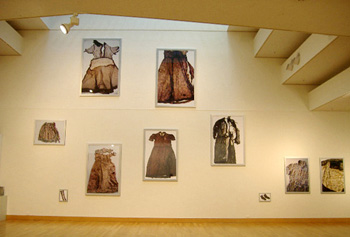 |
|
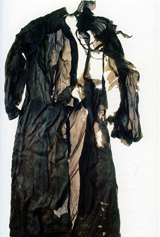 |
| Wall in the "Hiroshima" section of the Ishiuchi exhibition |
|
Miyako Ishiuchi,
"Hiroshima #71 (Dress),"
2007
© Miyako Ishiuchi
All images courtesy of the Meguro Museum of Art, Tokyo
|
|
|
|
|
 |
 |
|
 |
Meguro Museum of Art, Tokyo |
 |
|
|
2-4-36 Meguro, Meguro-ku, Tokyo
Phone: 03-3714-1201
Open 10:00-6:00, closed Mondays and December 28 - January 4
Transportation: 10 minutes walk from JR Meguro Station |
 |
|
|
 |
 |
Alan Gleason
Alan Gleason is a translator, editor and writer based in Tokyo, where he has lived for 24 years. In addition to writing about the Japanese art scene he has edited and translated works on Japanese theater (from kabuki to the avant-garde) and music (both traditional and contemporary). |
|
|
|
 |
 |
|